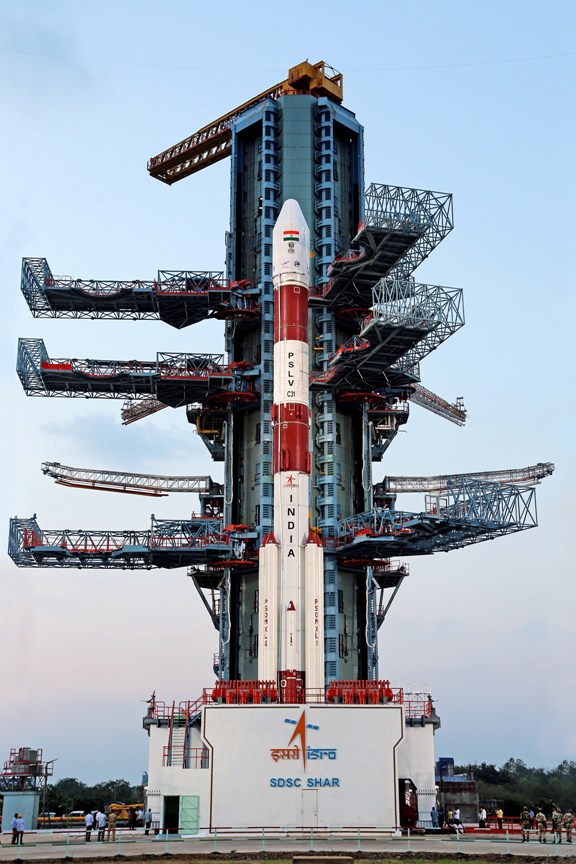 This is the thirty second consecutively successful mission of PSLV and the eleventh in its 'XL' configuration. This is the thirty second consecutively successful mission of PSLV and the eleventh in its 'XL' configuration.
After the PSLV-C31 lift-off at 0931 hrs (9:31 am) IST from the Second Launch Pad with the ignition of the first stage, the subsequent important flight events, namely, strap-on ignitions and separations, first stage separation, second stage ignition, heat-shield separation, second stage separation, third stage ignition and separation, fourth stage ignition and satellite injection, took place as planned.
After a flight of about 18 minutes 43 seconds, IRNSS-1E Satellite was injected to an elliptical orbit of 282.4 km X 20,655.3 km inclined at an angle of 19.21 degree to the equator (very close to the intended orbit) and successfully separated from the PSLV fourth stage. After injection, the solar panels of IRNSS-1E were deployed automatically. ISRO's Master Control Facility (at Hassan, Karnataka) took over the control of the satellite. In the coming days, four orbit manoeuvres will be conducted from Master Control Facility to position the satellite in the Geosynchronous Orbit at 111.75 deg East longitude with 28.1 deg inclination.
IRNSS-1E is the fifth of the seven satellites constituting the space segment of the Indian Regional Navigation Satellite System. IRNSS-1A, 1B, 1C and ID, the first four satellites of the constellation, were successfully launched by PSLV on July 2, 2013; April 4, 2014; October 16, 2014 and March 28, 2015 respectively. All the four satellites are functioning satisfactorily from their designated orbital positions.
IRNSS is an independent regional navigation satellite system designed to provide position information in the Indian region and 1500 km around the Indian mainland. IRNSS would provide two types of services, namely, Standard Positioning Services (SPS) - provided to all users - and Restricted Services (RS), provided to authorised users.
A number of ground stations responsible for the generation and transmission of navigation parameters, satellite ranging and monitoring, etc., have been
established in eighteen locations across the country. In the coming months, the remaining two satellites of this constellation, namely, IRNSS-1F and IG,
are scheduled to be launched by PSLV, thereby completing the entire IRNSS constellation.
President Pranab Mukherjee congratulated the ISRO for the successful launch of PSLV-C31 carrying IRNSS-1E, India’s fifth navigation satellite.
In a message to ISRO Chairman AS Kiran Kumar, the President said: “I extend my hearty congratulations to you and your entire team at the
Indian Space Research Organisation (ISRO) for the successful launch of PSLV-C31 carrying IRNSS-1E, India’s fifth navigation satellite of
the seven satellites constituting the India Regional Navigation Satellite System.
The launch marks an important landmark in our space programme and demonstrates, yet again, India’s capabilities in space
launch technology. With this launch, our nation is one step closer to an operational independent regional navigational satellite
system. This will help to provide real-time data on the position of objects to aid road, air and maritime traffic apart from
providing mapping and tracking services. The nation is proud of this achievement.
Kindly convey my greetings to the members of your team of scientists, engineers, technologists and all others associated
with this great mission. I wish all your future endeavours great success.”
Prime Minister Narendra Modi has also congratulated the ISRO scientists on the successful launch of PSLV C31, and precisely putting IRNSS 1E in the orbit.
His social media message read: "Congratulating the dynamism and determination of ISRO and our scientists on successful launch of PSLV C31 and putting IRNSS 1E in orbit precisely. Spoke to the scientists at ISRO and congratulated them on their accomplishment today. Our scientists keep making us proud."
|